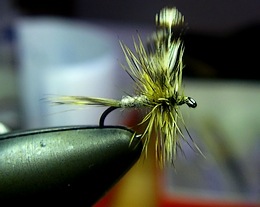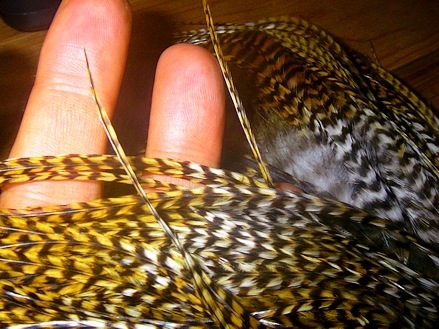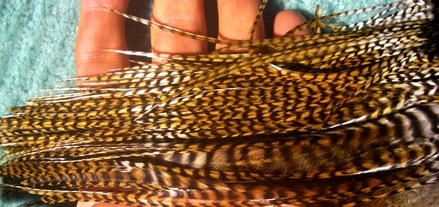There’s at least 175 ways to get this outcome accidentally, but only one way to do it intentionally…
Grizzly is one of those “must have” chickens that’s used on absolutely everything. Big feathers used on streamers, small feathers used on dry flies, and everything else used to make hackle tip wings or add mottling to nymph parts.
 Fly tiers that dye their own feathers are often tempted to toss all the other colors and just dye Grizzly necks Brown, Medium Dun or Ginger. Impressionists like myself love the mixture of colors on the feather – with the light bands somewhat indistinct, and the dark bars offering rigid color that define the fly.
Fly tiers that dye their own feathers are often tempted to toss all the other colors and just dye Grizzly necks Brown, Medium Dun or Ginger. Impressionists like myself love the mixture of colors on the feather – with the light bands somewhat indistinct, and the dark bars offering rigid color that define the fly.
I’d been fiddling with Jacquard Acid Dyes and streamer feathers – using the old “butt ends” of grizzly necks to tinker with yet another dubious idea. Dyeing is the best way to destroy materials and experimenting with new dyes always adds a couple extra foibles guaranteed to disappoint.
I ran out of the chestnut dyed grizzly used for the Calibaetis dry flies I use while lake fishing, and worked up enough nerve to dye a Hoffman Saddle with Jacquard’s version of Olive – which is actually a nice brown color.
Testing on a chunk of Red Fox confirmed it was a warm chestnut color, and I added a teaspoon of Aztec Gold to warm it further. I vacillate on this fly every season – some years I use natural Grizzly, and when that doesn’t work the next I’m tying the chestnut variant.
A feather with both would be perfect.

I’ve been playing with a “tie-dye” method for feathers that does something similar. I tightly wrap kite twine to a stick then bind the saddle onto the surface with concentric wraps of twine. Tied tight enough the twine prevents the dye from reaching the feather yielding a “bar” of natural color that can be dropped into a second color of dye (or left natural) to make multicolored hackle.
One look at typical baitfish explains why you’d want a multicolor effect – or the dyed-natural flavor, fish start with a light colored belly and a dark back – with many colors between the two.

Us retired commercial fly tiers recognize an Adam’s could be tied with one hackle. Not only would it be cheaper but it would be much faster too. While profit is no longer much of a motivation, like most fly tiers, I still hate using two hackles to tie one dry fly.
Large streamer hackles (some shown above) give a nice color transition from natural to brown. Olive would make another nice color to transition with yellow or similar light color. Toss this into a lighter colored dye bath, like yellow, and the brown would be untouched while the natural sections slurped up that yellow dye.
With this batch I tried a couple other cords all smaller than the kite twine, and all failed to hold the color at bay. I don’t think anything smaller than 30lb mono is capable of mashing the fibers tight enough.
Tags: tie dye, fly tying materials, grizzly hackle, Hoffman saddle hackle, chestnut, Jacquard’s Acid Dyes, Red Fox fur, dyeing fly tying materials

Is there no end to your madness?
Thanks for another great idea. I hope I cannot bring myself to ruin a perfectly good saddle attempt this at home.
That’s what all those old necks are for … the ones you used all the #16 and #18 hackle – and are hard pressed what to do with the rest..
Experiment on fur strips first – that’ll embolden you. hehe.